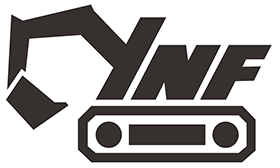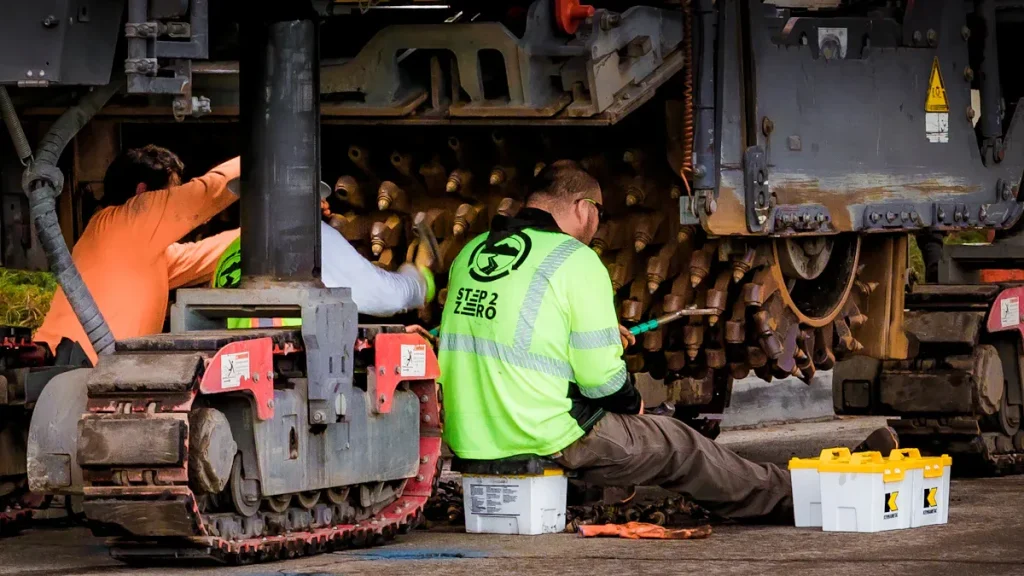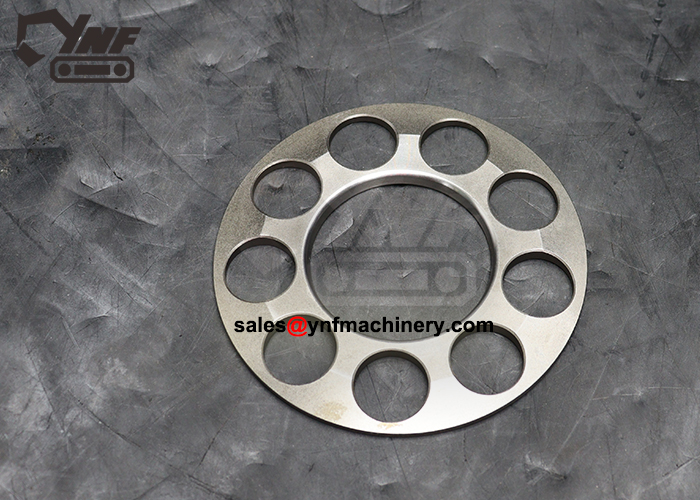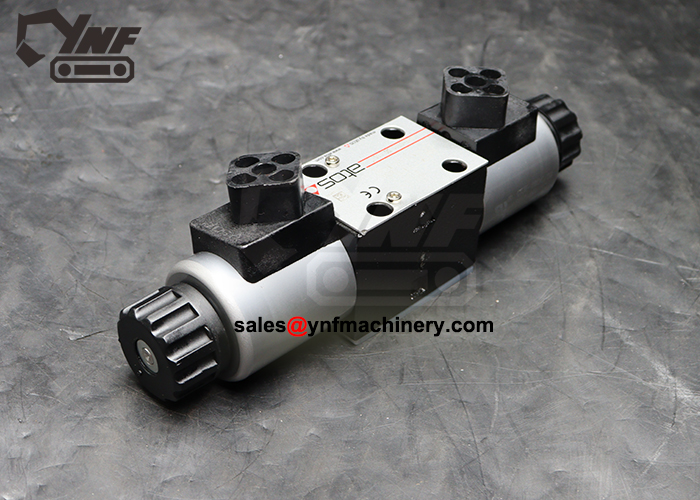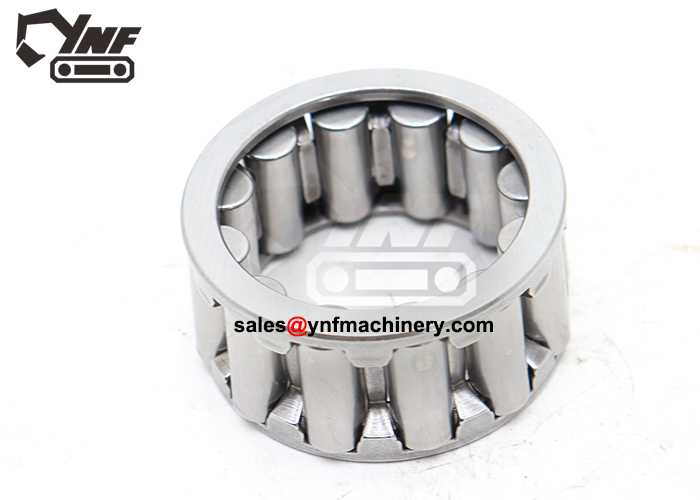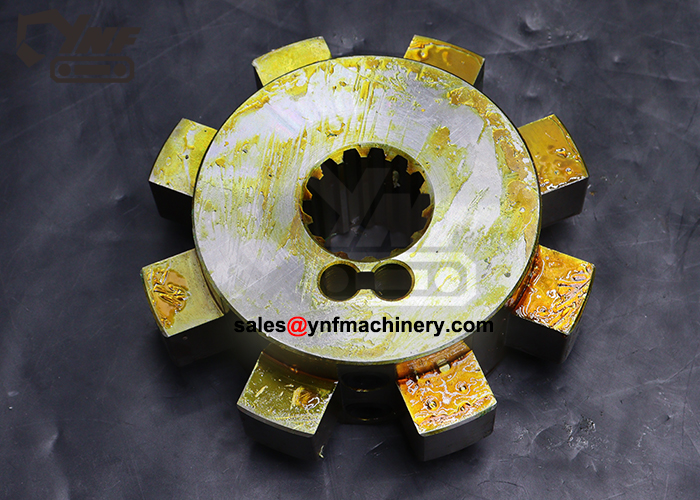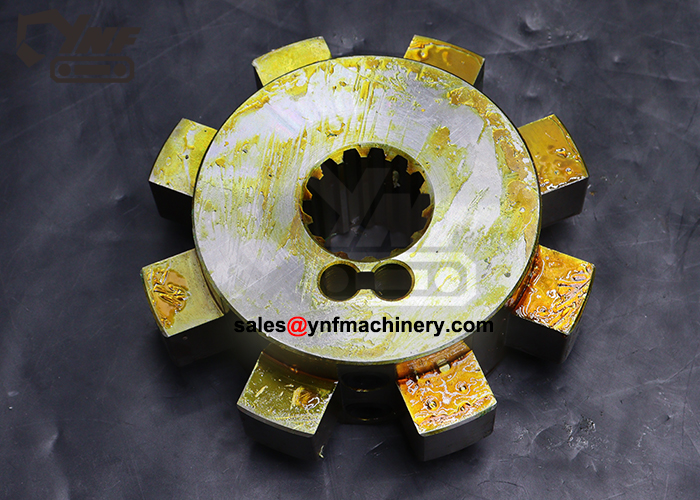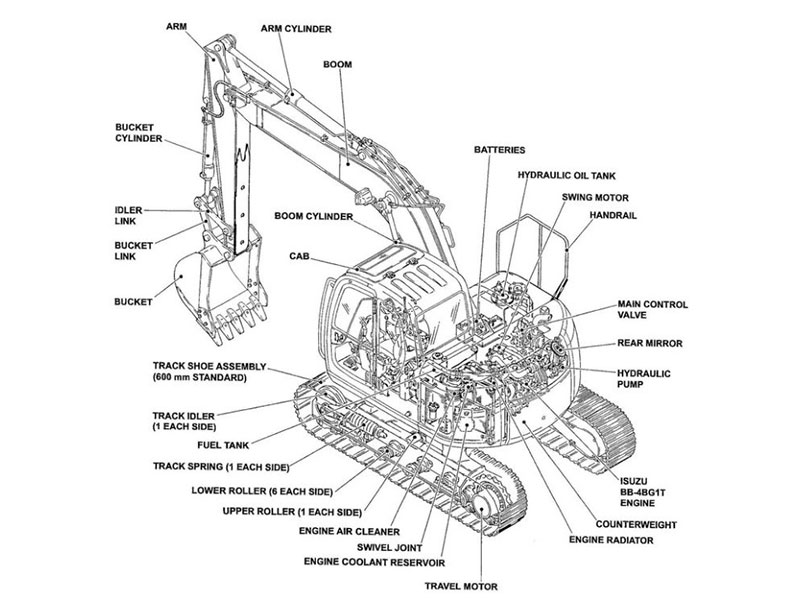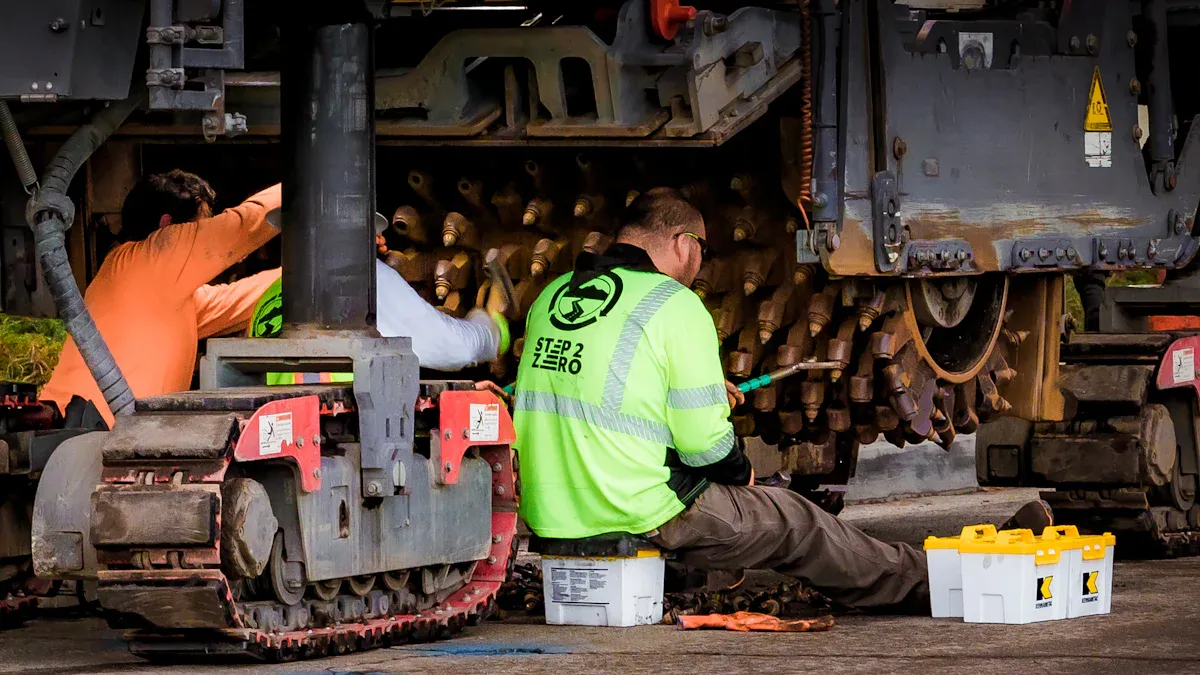
You keep your Cat 307 excavator working well by doing daily checks, cleaning, and following set routines. When you use real 307 cat excavator parts, you help stop breakdowns and expensive fixes. Change the oil every 250 hours and test the oil at each service to find early wear. Using telematics and watching the undercarriage can find problems before they get worse. These steps help your machine last longer and stay safe at work.
Key Takeaways
Use real Cat 307 excavator parts for good performance. This helps your machine last longer and work safely.
Check your excavator every day and clean it often. This helps you find problems early and stops expensive repairs.
Stick to a regular maintenance plan. Change oil and filters on time to keep your machine working well.
Look at attachments, hoses, filters, and the undercarriage often. Take care of these parts to stop breakdowns and make them last longer.
Write down all maintenance and repairs you do. This helps you plan and keeps your machine safe.
Quality Parts
Performance
You want your Cat 307 excavator to work at its best every day. Using original 307 cat excavator parts helps you reach that goal. These parts fit your machine perfectly and keep all systems running smoothly.
You get reliable operation from the hydraulics, powertrain, swing, and propulsion systems.
Each part meets strict factory standards, so you spend less time fixing problems and more time working.
Caterpillar tests rebuilt parts on powerful machines to make sure they last and perform well.
You can count on expert help to find the right part quickly, which keeps your downtime short.
The full range of parts covers everything from pumps and valves to engines and structural pieces.
When you choose original parts, you help your excavator stay strong and productive.
Longevity
You want your machine to last for years. Original parts help you do that. They resist wear and tear better than many aftermarket options. When you use the right parts, you protect your investment. Your excavator keeps working longer, and you avoid big repair bills. You also keep your operating costs lower over time. This means you get more value from your 307 cat excavator parts and your machine.
Safety
Safety matters every day on the job. When you use genuine parts, you help prevent breakdowns that could cause accidents. Each part goes through careful testing before it reaches you. This means you can trust your excavator to work safely, even in tough conditions. You also protect yourself and your crew by keeping your equipment in top shape.
Tip: Always check that your replacement parts come from trusted sources. This helps you avoid fake or low-quality parts that could put you at risk.
Maintenance Checklist
Daily Checks
Start each day by walking around your Cat 307 excavator. Look for leaks or loose bolts. Check for any damage you can see. Look at the undercarriage for mud, rocks, or trash. These things can cause trouble. Check hydraulic lines and connections for leaks or worn spots.
Check fluid levels like engine oil, coolant, and hydraulic fluid.
Look at the bucket, linkage, and attachments for cracks or too much wear.
Test lights, alarms, and safety features before you use the machine.
Tip: Write down any problems you find during your check. Finding issues early lets you fix them before they get worse and cost more.
Cleaning
Cleaning your excavator helps protect its parts. It also keeps it working well. Take off dirt and trash from the undercarriage every day. Mud and rocks can freeze or pile up. This can wear out parts or stop the machine from moving. Clean hydraulic lines and connections to keep out dirt.
Wipe and grease pivot points as the guide says.
Use only real Cat fluids and filters to keep parts in good shape.
Clean the cab and controls to keep your workspace safe.
Cleaning often keeps dirt, water, and metal bits out of the final drive system. This stops damage to gears and seals. It also helps your excavator last longer.
Daily cleaning and checking help you find leaks or damage early. This way, you can fix things before they break.
Cleaning often makes your machine more reliable and lowers repair costs.
Fluid Monitoring
Check fluid levels and look for leaks every day. Good lubrication helps your engine and hydraulics work well.
After you put in a new final drive, check the gear oil level right away.
Check again after 100 to 150 hours of use.
Keep checking every 500 to 800 hours.
Always look for leaks before you start work.
If you see low fluids or leaks, fix them right away. Using the right fluids and changing them on time keeps your machine safe from breaking down.
Scheduled Service
Follow a set plan for bigger maintenance jobs. How often you do these depends on how much you use the machine. You can track this by service hours, fuel use, miles, or time.
Change engine oil and filters every 250 hours.
Replace hydraulic filters and check hoses as your manual says.
Check and service the undercarriage, cooling system, and attachments often.
Note: Always use your Cat 307’s operation and maintenance manual to find the best times for service.
Keeping a regular schedule helps you avoid big repairs. It also helps your excavator last longer. Good records of all work make it easier to plan future service and spot problems early.
307 Cat Excavator Parts
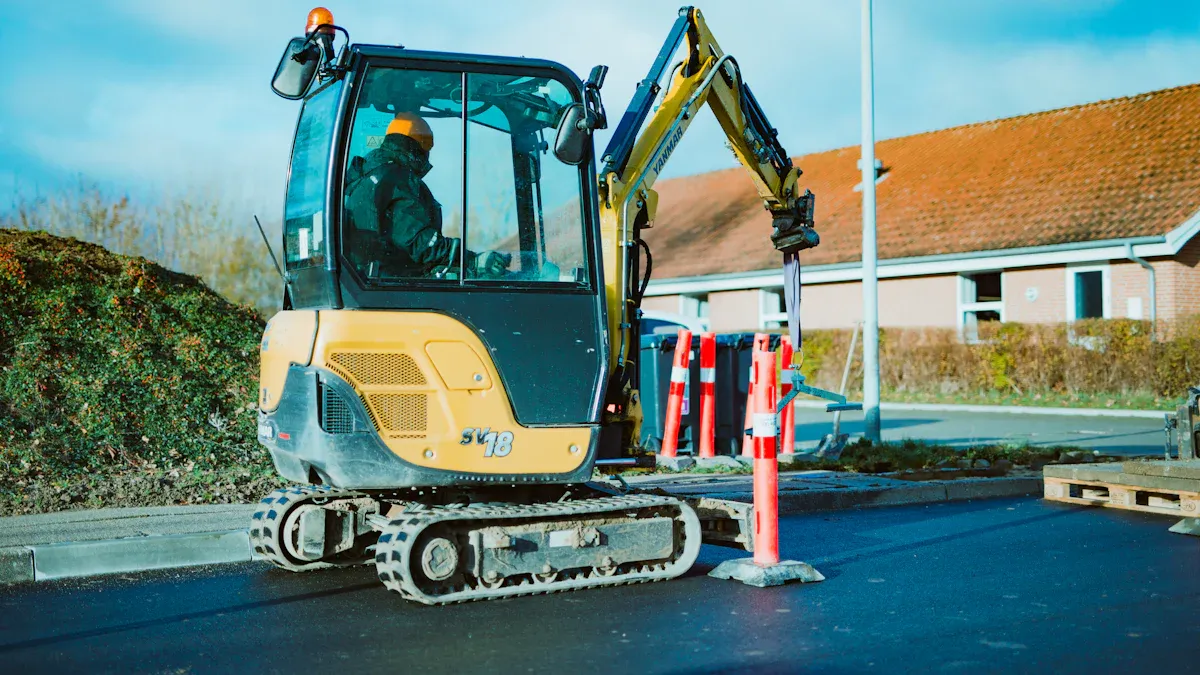
You keep your Cat 307 excavator strong by picking the right parts. Using real Caterpillar parts gives you better performance and reliability. This helps you avoid breakdowns and keeps your machine safe. Maintenance is also easier and faster with these parts.
Filters
Filters keep dirt and debris out of your engine and hydraulic system. You need to use real filters for your 307 cat excavator parts. These filters catch tiny bits and keep fluids clean. Clean fluids help your engine last longer and work better.
Air filters stop dust from getting into the engine.
Fuel filters take water and dirt out of the fuel.
Hydraulic filters keep oil clean so parts move smoothly.
Check your filters often and change them when your manual says. Watch for clogs or damage. Always buy filters from trusted sellers who give you real parts and clear paperwork.Tip: Ask for service records and test results when you buy filters. This helps you make sure they are real and good quality.
Attachments
Attachments help your Cat 307 excavator do more jobs. You can dig, lift, and move many things. Each attachment needs its own care. The table below lists common attachments and how they change your maintenance:
Attachment Type | Description / Features | Impact on Maintenance Requirements |
|---|---|---|
Buckets (including front shovel buckets) | Let you dig and load many ways; 180-degree turn helps keep material in and dig better | Need grease every 500 hours on the front part; easy-to-reach check points help with care |
Thumbs (thumb-ready stick) | Lets you grab and hold things with buckets | Hydraulic lockout and certified accumulator make connecting safer and lower wear and care needs |
Hydraulic Work Tools (auxiliary hydraulic lines, quick disconnects) | Let you use many hydraulic tools for different jobs | Need regular checks of the hydraulic system; pressure release system helps with safer care and connections |
Check attachments every day. Look for cracks, loose bolts, or worn pins. Grease moving parts as the guide says. Use only real 307 cat excavator parts for fixing or replacing.
Note: Real attachments have certified parts and safety features. This helps them last longer and lowers care risks.
Cooling System
The cooling system stops your engine from getting too hot. Check coolant levels and hoses often. Use only real radiators, water pumps, and hoses for your 307 cat excavator parts.
Look at the radiator for leaks or blockages.
Check hoses for cracks or soft spots.
Change coolant when your manual says.
Clean the cooling system to stop dirt from building up. This helps your engine stay cool and work well.Tip: Always use Cat-approved coolant and parts. This keeps your engine safe and stops big repairs.
Undercarriage
The undercarriage holds up your excavator and lets it move on rough ground. Watch for wear and damage. Using good undercarriage parts for your 307 cat excavator parts saves money and keeps your machine steady.
Bridgestone GeoGrip rubber track pads stop debris from building up with their special design.
Strong rubber and forged metals make pads last longer and fight wear.
Less debris and wear means you spend less time and money on care.
You can change single pads, which saves time and money.
These pads also lower vibration and noise, making your excavator safer and more comfortable.
Check the undercarriage every day. Look for loose bolts, worn pads, or broken rollers. Clean out mud and rocks to stop extra wear. Change worn parts with real Caterpillar parts for best results.
Tip: Good sellers give you real core parts, service papers, and test results. You can also use lists like Volza to find trusted sellers. These steps help you make sure you get real 307 cat excavator parts.
Maintenance Procedures
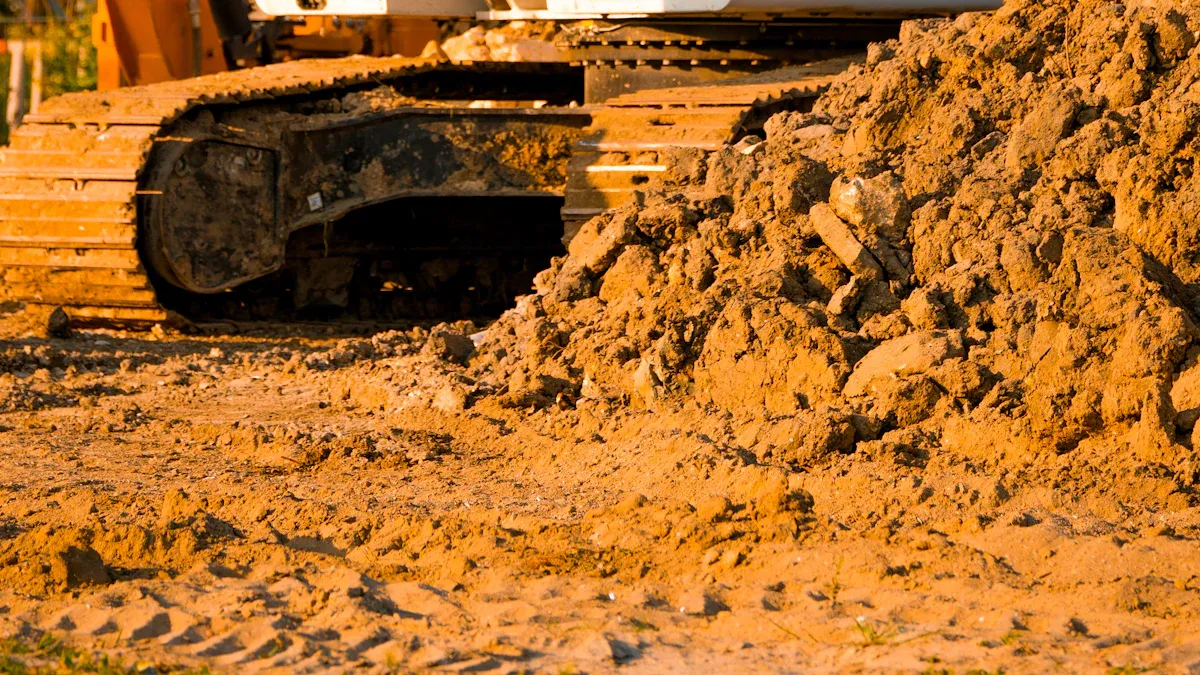
Filter Replacement
You keep your Cat 307 excavator running smoothly by changing filters on time. Start by turning off the engine and letting it cool. Find the filter you need to replace. Use a clean rag to wipe away dirt around the filter. Remove the old filter with the right tool. Check the filter mount for debris. Put a thin layer of clean oil on the new filter’s seal. Install the new filter and tighten it by hand. Fill the system with the correct fluid. Start the engine and check for leaks.
Tip: Always use genuine Cat filters. Follow the steps in your operation manual for best results.
Hose Inspection
You protect your excavator by checking hoses often. Look for cracks, bulges, or leaks. Touch each hose to feel for soft spots. Check fittings for tightness. If you see oil or fluid leaks, fix them right away.
Clean hoses before you inspect them.
Replace damaged hoses with original Cat parts.
Use safety gloves and eye protection.
Neglecting leaks can let dirt enter the system and cause major damage. Always address leaks quickly.
Track Service
You keep your undercarriage strong by cleaning and checking tracks every day. Mud and rocks can push seals out of place and cause leaks. Use a pressure washer to clean around the drive motor at the end of each shift.
Inspect track pads for wear or cracks.
Tighten loose bolts.
Replace worn pads with genuine parts.
Check the floating face seals for leaks.
If you see gear oil leaking, stop and repair the seal. This prevents sludge buildup and costly repairs.
Lubrication
You help your excavator last longer by greasing moving parts. Use the grease points listed in your manual. Wipe away old grease and dirt before adding new grease.
Grease pivot points, bucket pins, and swing bearings.
Use Cat-approved lubricants.
Record each lubrication in your maintenance log.
Regular lubrication reduces friction and wear. Cleanliness keeps contaminants out and protects your machine.
Note: Always follow your Cat 307 operation and maintenance manual for detailed steps. Clean parts before you work. Use safety gear. Routine care helps you avoid common mistakes and keeps your excavator working safely.
Troubleshooting
Wear Signs
You can spot wear early if you know what to look for. Regular checks help you catch problems before they get worse. Here are some signs that show your Cat 307 excavator needs attention:
Hydraulic oil leaks around hoses or connections
Premature wear on hydraulic pump seals
Loose bolts on the undercarriage or attachments
Damage or cracks in rubber belt tracks
Sluggish hydraulic response when you move the controls
Unusual noises like grinding or knocking from the engine or hydraulic system
Worn bucket tips, side cutters, or linkage parts
If you see any of these signs, you should inspect the area closely. Early action helps you avoid bigger repairs and keeps your machine safe.
Tip: Write down any wear signs you find during your daily walk-around. This record helps you track changes and plan repairs.
Common Issues
You may face several common problems with your Cat 307 excavator. Knowing what causes these issues helps you fix them faster.
Worn out parts often result from regular use or contamination.
Damaged bearings can make gears move poorly and cause more damage.
Low oil pressure leads to poor lubrication, more friction, and faster wear.
Contamination from dirt, water, or metal shavings harms gears, bearings, and seals.
Seal failure lets oil leak and dirt enter, which wears out internal parts.
Early warning signs include strange noises, slower travel speed, trouble steering, more vibration, and high heat. If you notice these symptoms, check your machine right away.
Replacement Timing
You need to know when to replace parts to keep your excavator running well. Most Cat 307 excavators last between 7,000 and 10,000 hours before needing major repairs. You should replace worn parts as soon as you see damage or performance drops.
Change filters, lubricants, and hydraulic screens at scheduled intervals.
Replace bucket tips, side cutters, and rubber tracks when you see cracks or heavy wear.
Fix seals and bearings if you spot leaks or hear grinding noises.
Note: Following your maintenance schedule and watching for wear signs helps you avoid costly breakdowns. Replace parts before they fail to keep your Cat 307 safe and strong.
Longevity Tips
Storage
You keep your Cat 307 excavator safe by storing it right. Park it on flat, strong ground. Stretch out the digging equipment to cover piston rods. This helps protect them from weather and harm. In winter, tilt the undercarriage a bit. This stops mud and junk from freezing on moving parts. Put covers on open hydraulic lines and wires. This keeps out water and dust.
Tip: Keep your excavator away from busy spots. This lowers the chance of bumps or scrapes.
Storing your machine well keeps it ready to use. It also cuts down on wear. You will have fewer repairs and your parts last longer.
Cleaning
Cleaning your excavator often helps stop big repairs. Take off dirt, rocks, and plants from the undercarriage after each shift. This keeps junk from packing tight near the drive motor. It also stops seals from getting pushed out. Clean bucket linkages and hydraulic lines to keep out dirt.
Look for worn or broken track shoes and sprockets.
Check hydraulic hoses for leaks or cracks.
Use a pressure washer to clean the undercarriage, especially in winter.
Check your machine every day to find small problems early. Write down anything odd so you can fix it fast. Keeping your excavator clean helps parts last longer and makes maintenance easier.
Records
Good records help you watch your machine’s health and plan fixes. Write down every service, oil change, and filter swap.
A full service history makes your machine worth more.
Machines with care and records sell for better prices.
Logs show buyers your excavator got the right care.
Keep oil test results and notes in one spot. Use a calendar or computer to plan future services.
Note: Good records help you see patterns and plan ahead. You save money and your Cat 307 excavator works longer.
Smart storage, cleaning, and keeping records help you avoid big repairs. These steps make your excavator last longer.
You help your Cat 307 excavator stay strong by checking it every day and using real 307 cat excavator parts. Cleaning it often and doing service on a schedule stops big repair bills.
Look at your machine daily for leaks or broken parts.
Pick real parts to keep your machine safe and working well.
Write down all the work you do so you can plan ahead.
Begin your next check today. Follow your service manual to keep your excavator safe and working right.
FAQ
How often should you change the engine oil on a Cat 307 excavator?
You should change the engine oil every 250 hours of use. Always check your operation manual for the best schedule. Clean oil helps your engine last longer and work better.
What are the signs that a hydraulic hose needs replacing?
Look for cracks, bulges, leaks, or soft spots on the hose. If you see oil around the fittings or notice weak hydraulic power, replace the hose right away.
Why should you use genuine Caterpillar parts?
Genuine parts fit your machine perfectly. They last longer and keep your excavator safe. Using real parts helps you avoid breakdowns and costly repairs.
How do you keep the undercarriage in good shape?
Clean the undercarriage after each shift.
Check for loose bolts, worn pads, or broken rollers.
Remove mud and rocks to stop extra wear.
Replace worn parts with real Caterpillar parts for best results.
